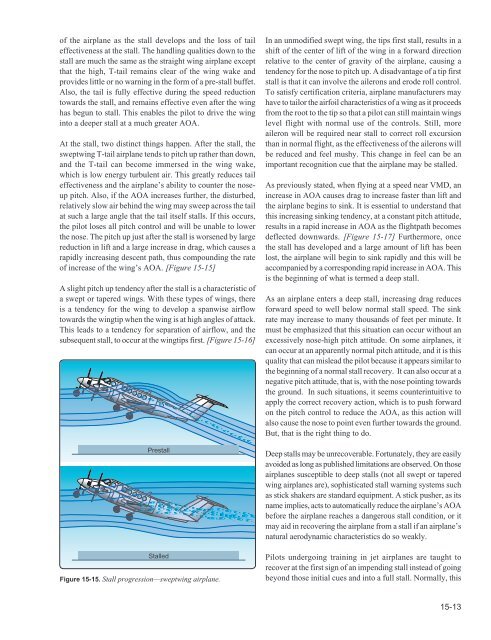Create successful ePaper yourself
Turn your PDF publications into a flip-book with our unique Google optimized e-Paper software.
of the airplane as the stall develops and the loss of tail<br />
effectiveness at the stall. The handling qualities down to the<br />
stall are much the same as the straight wing airplane except<br />
that the high, T-tail remains clear of the wing wake and<br />
provides little or no warning in the form of a pre-stall buffet.<br />
Also, the tail is fully effective during the speed reduction<br />
towards the stall, and remains effective even after the wing<br />
has begun to stall. This enables the pilot to drive the wing<br />
into a deeper stall at a much greater AOA.<br />
At the stall, two distinct things happen. After the stall, the<br />
sweptwing T-tail airplane tends to pitch up rather than down,<br />
and the T-tail can become immersed in the wing wake,<br />
which is low energy turbulent air. This greatly reduces tail<br />
effectiveness and the airplane’s ability to counter the noseup<br />
pitch. Also, if the AOA increases further, the disturbed,<br />
relatively slow air behind the wing may sweep across the tail<br />
at such a large angle that the tail itself stalls. If this occurs,<br />
the pilot loses all pitch control and will be unable to lower<br />
the nose. The pitch up just after the stall is worsened by large<br />
reduction in lift and a large increase in drag, which causes a<br />
rapidly increasing descent path, thus compounding the rate<br />
of increase of the wing’s AOA. [Figure 15-15]<br />
A slight pitch up tendency after the stall is a characteristic of<br />
a swept or tapered wings. With these types of wings, there<br />
is a tendency for the wing to develop a spanwise airflow<br />
towards the wingtip when the wing is at high angles of attack.<br />
This leads to a tendency for separation of airflow, and the<br />
subsequent stall, to occur at the wingtips first. [Figure 15-16]<br />
Prestall<br />
Stalled<br />
Figure 15-15. Stall progression—sweptwing airplane.<br />
In an unmodified swept wing, the tips first stall, results in a<br />
shift of the center of lift of the wing in a forward direction<br />
relative to the center of gravity of the airplane, causing a<br />
tendency for the nose to pitch up. A disadvantage of a tip first<br />
stall is that it can involve the ailerons and erode roll control.<br />
To satisfy certification criteria, airplane manufacturers may<br />
have to tailor the airfoil characteristics of a wing as it proceeds<br />
from the root to the tip so that a pilot can still maintain wings<br />
level flight with normal use of the controls. Still, more<br />
aileron will be required near stall to correct roll excursion<br />
than in normal flight, as the effectiveness of the ailerons will<br />
be reduced and feel mushy. This change in feel can be an<br />
important recognition cue that the airplane may be stalled.<br />
As previously stated, when flying at a speed near VMD, an<br />
increase in AOA causes drag to increase faster than lift and<br />
the airplane begins to sink. It is essential to understand that<br />
this increasing sinking tendency, at a constant pitch attitude,<br />
results in a rapid increase in AOA as the flightpath becomes<br />
deflected downwards. [Figure 15-17] Furthermore, once<br />
the stall has developed and a large amount of lift has been<br />
lost, the airplane will begin to sink rapidly and this will be<br />
accompanied by a corresponding rapid increase in AOA. This<br />
is the beginning of what is termed a deep stall.<br />
As an airplane enters a deep stall, increasing drag reduces<br />
forward speed to well below normal stall speed. The sink<br />
rate may increase to many thousands of feet per minute. It<br />
must be emphasized that this situation can occur without an<br />
excessively nose-high pitch attitude. On some airplanes, it<br />
can occur at an apparently normal pitch attitude, and it is this<br />
quality that can mislead the pilot because it appears similar to<br />
the beginning of a normal stall recovery. It can also occur at a<br />
negative pitch attitude, that is, with the nose pointing towards<br />
the ground. In such situations, it seems counterintuitive to<br />
apply the correct recovery action, which is to push forward<br />
on the pitch control to reduce the AOA, as this action will<br />
also cause the nose to point even further towards the ground.<br />
But, that is the right thing to do.<br />
Deep stalls may be unrecoverable. Fortunately, they are easily<br />
avoided as long as published limitations are observed. On those<br />
airplanes susceptible to deep stalls (not all swept or tapered<br />
wing airplanes are), sophisticated stall warning systems such<br />
as stick shakers are standard equipment. A stick pusher, as its<br />
name implies, acts to automatically reduce the airplane’s AOA<br />
before the airplane reaches a dangerous stall condition, or it<br />
may aid in recovering the airplane from a stall if an airplane’s<br />
natural aerodynamic characteristics do so weakly.<br />
Pilots undergoing training in jet airplanes are taught to<br />
recover at the first sign of an impending stall instead of going<br />
beyond those initial cues and into a full stall. Normally, this<br />
15-13


